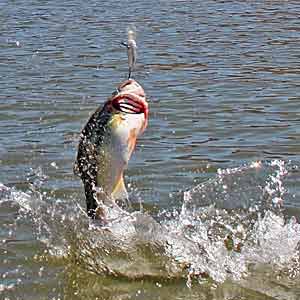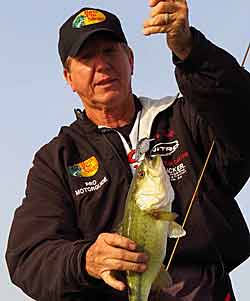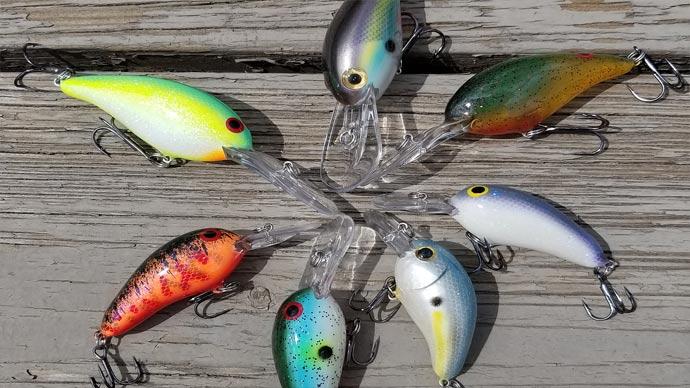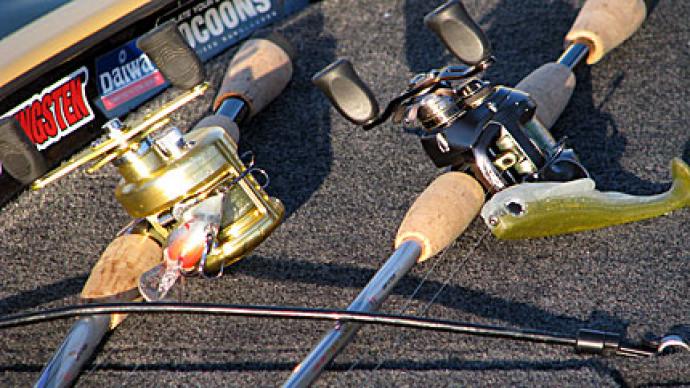
You can catch fish on a crankbait by throwing it out and cranking it back in. It’s so easy a child could do it. A lot of anglers consider crankbaits idiot baits. A simple retrieve will indeed catch, but if your goal is to catch a lot of bass on a crankbait, it pays to learn a few tricks.
Crankbaits wobble in the water. Some wobble a lot; some wobble a little. The wobbling displaces water and sends waves to a bass’s lateral line, letting it know that something in the water is swimming a little weird. Usually, this means a relatively easy meal. A steady retrieve will catch a certain number of fish, but you’ll catch a lot more if you do something to trigger the bites. Crashing a crankbait into cover – stumps, rocks, rip rap, docks – is ideal. If there aren’t any obstacles where you’re fishing, crash it into the bottom by choosing a deep-running crankbait.
If you overdo the trigger, it becomes part of the steady retrieve. If you are using a pause and jerk as a trigger, don’t do it every couple of feet, or it becomes part of a rather boring pattern. Try to make your jerks and pauses as random as possible, and give the fish at least ten feet between triggers.
Of course, there are exceptions to every rule. If you’re fishing in the dark or muddy water, you’ll have to keep your retrieve reasonably steady for the fish to locate the bait. In those cases, a darker lure is the best choice because it will show up better silhouetted against the sky as a bass comes up under and behind it.
Usually, when the water comes up, the fish come right up with it. Arizona Bass Pro Shops and Nitro Pro Gary Senft has been fishing long enough to know that there are no guarantees regarding bass behavior. “This week, the lake has come up at least two feet, but the fish haven’t followed it,” he told us as he tied on a jointed Rapala.
“Starting on points is key to finding fish right now,” he added, “but we have to find out whether they’re on points in the backs of coves or out on the main lake.” A sunny day right after a cold front with 58-degree water may not be the ideal conditions for catching big bass, but a tournament angler learns to roll with the punches.
Gary usually starts with a white or chartreuse crankbait when the bass are eating shad, or a brown or orange plug if they’re eating craws. His boat is stocked with various crankbaits that run at various depths. “I’ll usually try a variety of shallow and deeper baits in the same color when I’m starting out looking for active fish,” he said. Different parts of the lake have different colored water. When Senft moves into a muddy area, he picks up a darker bait such as blue or fire tiger.
In clear water, his first choice is a white or silver lure. He reserves the chartreuse baits for stained water that calls for a more visible lure. “If there are two people fishing, it helps if both of them throw different baits,” he adds. “The guy in the back can either throw one that runs at a different depth or choose one that’s a different color.” He’ll often choose a jerk bait over a crankbait in clear water. He likes Lucky Craft jerk baits.
Senft favors rocky banks for cranking, and his favorites have about a 60-degree slant and chunk rock. Those are the ones that crawdads love. He keeps the boat relatively close and fishes parallel to the shoreline, dissecting the bank as he moves. Since the water has come up and the bass have not, he’s using a slightly deeper-running lure.
“On plain sandy banks, I don’t usually catch many fish,” says Senft. “On a bank like that, there needs to be a tree, brush, or something to hold the fish.” He likes to make the plugs bang into things, crashing off rocks and submerged trees. You can lose a lot of baits that way, but you can also catch a lot of big fish.
As he fishes, Senft watches the graph for bait fish. He’ll change lures based on how deep the bait fish are. There’s always the possibility that they won’t eat a reaction bait today, too,” he says. “It may be that they’re in pre-spawn mode and are just hanging out. But it’s always worth a try because if you can get a crankbait bite going, you can get a limit pretty quickly.”
Stocking Your Box

Buying crankbaits randomly, based on whatever looks good, can leave you scratching your head once you hit the water. You need to stock your tackle box logically. Gary keeps a variety of crankbaits that run shallow, medium, and deep. “When I choose a lure, I usually buy three different models,” he says. “The only thing that changes is the size of the bill. Deeper running baits have longer bills but present the same profile to the bass.” Favorites of his include Rapalas and a bunch of Bomber lures, including the Fat-Free family of plugs. He likes the jointed Rapalas because they have a little wiggle to the back, giving them a slightly different action.
How deep a bait will run is usually printed prominently on the package, but sometimes this is an idealized goal. The actual depth you’ll get out of a lure depends on the diameter of your line, the distance you can cast, and other esoteric stuff. Usually, what it says on the box is a good starting point.
Despite what you may have been told, the speed of your retrieve does not affect the depth of your crankbait. How you hold the rod does, however. But try not to worry too much about that stuff. Once you’ve fished a bait a few times, you’ll know how deep it runs if you keep an eye on the depthfinder and notice when it runs into things. As with all things, your crankbait fishing will improve with practice.
Once you’ve chosen a few models of each depth, it’s time to think about colors and patterns. Some crankbaits are so beautiful that you almost hate the thought of putting them in the water. Remember that what attracts fishermen is not necessarily what attracts bass. What you need is baits that look like food. If shad are the primary forage in your lake, choose shad-pattern crankbaits. Everyone should have some crankbaits that look like crawdads, too. Bass love crawdads, and bouncing a crawfish crankbait around on the rocks is an easy way to bag a bass or two no matter where you live.
You want to match the baitfish or the crawdads where you are fishing, says Senft, so he keeps colors basic. You need browns, whites, greens, and natural baitfish colors. “As a rule of thumb, the smaller bass eat the shad, and the bigger ones eat the crawdads,” he says. “That’s why jigs catch bigger fish.”
Out Of The Box
Many crankbaits nowadays are equipped with first-class hooks and good, solid split rings. This isn’t always the case, though. Generally, if a crankbait has excellent hooks, they’ll brag about it on the box, so read the package. If it doesn’t mention the hooks, you will be doing yourself a favor if you change them. I’ve had big bass straighten out the cheap hooks on some crankbaits.
You might want to put slightly larger hooks on the bait while at it. Be careful not to go too big, or you’ll change the action. There are all kinds of different styles of treble hooks now: Gamakatsu has trebles with EWG style hooks, and Mustad Triple Grips are great, too.
Whatever hook you choose, replace the split rings while you’re at it. If a company is going to put cheap hooks on a bait, odds are they aren’t buying first-class split rings, either. Gary has tried the Owner tear drop split rings and likes them. These egg-shaped split rings are made to spread apart with strong, constant pressure. You use them to attach the hooks to your lures, and if you get fatally snagged, you just pull hard and smoothly, and the hook comes off, so you get your crankbait back. Gary says they have worked well so far – none have given way while landing a fish.
While at it, replace the split ring at the front of the bait. Some lure companies already use the oval split rings on the front of their fantastic lures. With an oval split ring, you never have to worry about your line getting between the wires and getting damaged. They are incredibly strong, too.
Tackle and Equipment
Crankbaits need a little bit of line stretch. Braid or fluorocarbon line will tend to take a crankbait away from a fish, so mono is the way to go. Gary likes Bass Pro Extreme Line in 10- or 12-pound-test. “I’ve never broken a fish off with that line,” he states.
“And, it’s affordable. You can go as heavy as 15-pound, but it changes the action and depth of your lure.” His crankbait rod is also a Bass Pro Extreme. Gary says a 7-foot medium action rod is an excellent crankbait rod. He also likes Rogue Rods crankbait rods. Your crankbait rod should have some bend to it, with a lot of strength near the butt. When a fish first hits a crankbait, the rod should give a little, so the fish has a chance to eat the lure, then it should be able to deliver the goods and set the hook.
Choosing a reel is pretty simple. A reel with about a 5.1:1 ratio is ideal for fishing crankbaits with most anglers. A higher ratio will make you fish a plug too fast at a standard crank. If you’re the hyper type who just can’t slow down, you might even want to go to a 3.8:1, so you don’t burn all your baits past the fish so fast that it scares them.
You’ve replaced the hooks and split rings on your plugs, but don’t forget that even the best hooks can break or get dull after catching a few hundred big bass. Checking the hooks for sharpness and condition will pay off. Replace them as needed. You are sometimes adding red hooks to a crankbait results in more bites.
Nets make it easier to get a fish in the boat without sinking treble hooks into your hands, and Gary won’t use anything but a coated net. “If they’re not coated, they take the slime off the fish, and that’s pretty much a death sentence,” he said. “I hate to see guys on television dropping fish on the carpet. That’s bad for them.” Also, the hooks don’t snag on the coated nets. With a regular woven net, the trebles always seem to sink into the wet fibers past the barb. I know a guy who cut the net so many times to get the hooks out that he lost a big fish through one of the resulting holes!
Retrieve
Varying your retrieve is crucial to fish crankbaits successfully. Anybody can catch a fish now and then by simply chunking and winding, but an experienced angler will change things up now and then to see what happens. Sometimes killing the bait occasionally will trigger a strike. “You need to play with your retrieve,” Senft says. He’ll try varying his retrieve speed until he starts catching fish. Sometimes the amount of wobble a bait has is the deciding factor. Fatter baits wobble more, says Senft, as do wider bills. He’s found that less active fish generally prefer a tighter wobble.
With a quarter-ounce Rat-L-Trap, you can get creative with your retrieve. Gary has one that he has put red hooks on, and he fishes it almost like a jerk bait. He’ll crank it for a bit, then stop. He’ll rip it a little, but he mostly cranks pretty quickly, then stops to a count of four, so the lure drops. Fish grab it in the fall.
Spring and fall seem to be the best time of year for catching crankbait fish, but Senft doesn’t necessarily end up with a livewell full of crankbait fish at the end of the day. The crankbait is a searching tool a lot of the time. For instance, during pre-spawn, a crankbait can locate fish, but he’ll go back over the area with a worm or a jig, fishing a little deeper to try for bigger fish.
In clear water, when the fish are too savvy to grab a plug, a crankbait can still be used to make them show themselves. They may come out, look, and then go back into cover. You can go after them with a finesse bait or a jig once you know where they are. Gary cashes some pretty good checks at tournaments, and crankbaits are a big part of his strategy.
They should be part of your strategy too. Don’t make the mistake of thinking that plugs are “idiot baits.” With the right equipment and a good retrieve, you can use crankbaits to find bass AND catch them.
BassResource may receive a portion of revenues if you make a purchase using a link above.




